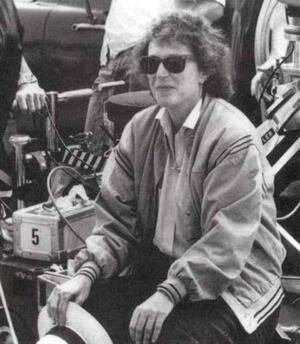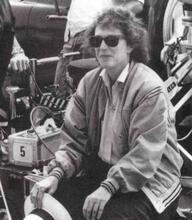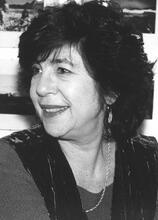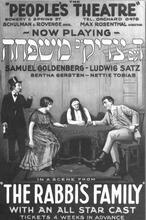Joan Micklin Silver
Joan Micklin Silver, born in 1935 in Omaha, Nebraska, was an award-winning director and screenwriter, who broke barriers with her 1975 film Hester Street, which helped popularize Jewish stories for Jewish and mainstream audiences and established Silver as a pathbreaking female, independent director. Silver also directed the 1988 romantic comedy film Crossing Delancey, five other feature films, and several films for television as a “director for hire,” including Finnegan, Begin Again (1984). She also wrote for the theater plays such as A…My Name is Alice (1984). Silver influenced countless independent filmmakers with a career as a director in film, television, and radio that spanned nearly fifty years.
Joan Micklin Silver, award-winning director and screenwriter, broke barriers with her 1975 film Hester Street, which helped popularize Jewish stories for Jewish and mainstream audiences and established Silver as a pathbreaking female, independent director. Displaying passion for her subjects as well as belief in herself as a screenwriter and visual storyteller, Silver brought her own style of directing to her craft, applying lessons she learned by observing and reading about famous directors. With tenacity in a film industry often hostile to women directors, and determined to bring to the screen stories inspired by her family and her interest in people and relationships, Silver carved a path that influenced countless independent filmmakers through a nearly fifty-year career as a film, television, and radio director.
Family and Early Career
Joan Micklin Silver was born in Omaha, Nebraska, on May 24, 1935, to Russian Jewish parents Maurice David and Doris (Shoshone) Micklin. She graduated from Omaha Central High School in 1952 and Sarah Lawrence College in 1956. Fresh out of college, she married Raphael D. (Ray) Silver, son of well-known Rabbi Abba Hillel Silver of Cleveland. The Silvers lived in Cleveland from 1956 to 1967 and raised three daughters: Dina (b. 1958), Marisa (b. 1960), and Claudia (b. 1963).
In Cleveland, Silver taught music and wrote plays, five of which were performed at Cleveland theaters. In 1967, the Silvers moved to New York, and Silver began to write films for educational film companies. One company, the Learning Corporation of America, commissioned her to write and direct films, including The Immigrant Experience, which won several awards. For that film, Silver drew on archival black and white photographs by Lewis Hines and others, and this research sparked her interest in the story that became Hester Street.
As she began to think about directing a feature film, Silver wrote an original screenplay, Limbo, about the wives of prisoners of war in Vietnam, which was purchased by Universal Pictures and made into a film in 1972, directed by Mark Robson. Though Silver clashed with Robson over the character of the film’s heroine and was subsequently fired, she received story and co-scripting credits in the final film. She also accepted an invitation from Robson to observe him in production on the film set, with access to actors, crew, budgets, and production documents, an experience that became Silver’s film school replacement.
Hester Street
Eager to write and direct her own film, Silver embarked on Hester Street, which she adapted from the 1890s novella Yekl by Abraham Cahan, who later became the famous editor of the Jewish Daily Forward newspaper. Interviewed by American Film magazine in 1989, Silver spoke about her choice of subject for Hester Street: “I thought, I’m going to make one that will count for my family. My parents were Russian Jewish, and my father was no longer living, but I cared a lot about the ties I had to that world. So that was how Hester Street started.”
Working with her husband, Raphael Silver, as producer, Joan Silver defied film industry insiders who insisted that women were “one more problem” they didn’t need and that Jewish films would never reach a general audience. Hester Street centers on the conflict between Jake, an immigrant man who prides himself on his assimilation to America, and his newly arrived wife Gitl, whose old-country ways embarrass and shame him. With a cast headed by the actress Carol Kane, Silver directed Hester Street without studio backing for a budget of $400,000.
Problems began when production on Hester Street ended and Silver wanted to release her film to the general public. “We sent the film around to everyone, and I mean nobody wanted to release it” (Pressman, 2005). Turned down by every major studio as an “ethnic oddity … a lovely film, but for a Jewish audience,” Silver and her husband, a real estate developer, decided to distribute the film themselves. They were invited to film festivals, and at the Cannes Film Festival, Ray Silver sold the film’s rights to several foreign countries, the proceeds of which allowed the Silvers to release the film themselves. It opened at the Plaza Theater in New York in 1975, in the midst of a record downpour, and yet “there was a line of people with umbrellas. It became an extremely successful film.” (Pressman, 2005). When Carol Kane received an Academy Award nomination for best actress, “the film opened everywhere.”
Silver received a Writers Guild of America nomination for best screenplay for Hester Street, and in the United States alone the film grossed five million dollars.
Later Films
Despite the success of Hester Street and a California studio’s interest in backing Silver’s second film, the studio balked when Silver told them specifics about the film she wanted to direct, Between the Lines, which focused on a group of young people working for an alternative newspaper in Boston. Once again, Silver’s husband Ray produced and distributed Between the Lines, released in 1977. Working with an ensemble cast, Silver encouraged her actors to improvise during rehearsals and used those improvisation sessions in rewriting her script, a mode of working that defined her approach to directing throughout her long career. Silver’s third feature film, Chilly Scenes of Winter, based on a short story by Ann Beattie, marked the beginning of her work with a movie studio. The film was originally released by United Artists in 1979 as Head Over Heels, but it was retitled and rereleased by United Artists Classics in 1981 as Chilly Scenes of Winter.
Cherishing her independent working style, with or without studio backing, Silver remarked, “the more I’m left alone, the better I do” (Pressman, 2005). She put that philosophy into play with her next Jewish-themed film, Crossing Delancey, a romantic comedy about an assimilated, single Jewish Manhattanite (played by Amy Irving) and her Lower East Side pickle-selling boyfriend (played by Peter Riegert), produced for Warner Brothers and released in 1988. As Silver noted in a 2005 Directors Guild of America interview, “They [Warner Brothers] just left me alone to make the movie, and I had a fabulous time.”
Silver directed two other films backed by movie studios, Loverboy (1989) and Big Girls Don’t Cry, They Get Even (1991), but she was also eager to make another film as an independent filmmaker with her husband as producer. She said she “felt like it’d be fun to make a film ourselves again after all these things I’d done … the TV movies and the two studio movies” (Pressman, 2005). For A Fish in the Bathtub (1998), starring Anne Meara and Jerry Stiller, about an older couple who poorly negotiate too much time together, Silver again improvised with her actors to enliven her script and enhance her directing. “We had all these readings and rehearsals at our apartment … and we would just all sit around the table and eat and talk … and come up with new things” (Pressman, 2005).
TV Movies and Theater Work
Reflecting on her long career directing films, Silver summarized, “When I first started out, all my crew members would say, ‘you don’t have any trouble saying, how should I do this? I haven’t done this before.’ I don’t think it diminishes me, and I don’t think any woman does” (Pressman, 2005). Silver acknowledged that her vulnerability as a new director gave her considerable strength.
In between working on her own films, Joan Micklin Silver had a prolific career directing films for television. “It was fun to know that I could be a director for hire and still find satisfaction in it.” Among her favorites was the film Finnegan, Begin Again (1984), starring Robert Preston and Mary Tyler Moore.
Silver’s writing extended beyond film to theater. Her works included A … My Name Is Alice (1984), A … My Name Is Still Alice (1992), Album (1980), and Maybe I’m Doing It Wrong (1982). The films she directed for television include Bernice Bobs Her Hair (1975), Parole Board (1990), A Private Matter (1992), In the Presence of Mine Enemies (1997), which takes place in the Warsaw Ghetto, and Charms for the Easy Life (2002).
In addition, Silver directed a radio series (coproduced by the National Yiddish Book Center) for National Public Radio, Great Jewish Stories from Eastern Europe and Beyond, in 1995.
As a successful director who often worked outside the Hollywood studio system, Silver was a pathbreaker. Garnering writing and production awards and box office successes, she showed not only that women could direct films but that films about Jewish topics could succeed with Jews and non-Jews alike. With a critical reputation for presenting characters with quirky intelligence, grace, and humor, Joan Micklin Silver pursued a strikingly versatile career in film, television, theater, and radio and opened doors for others, including those often seen by movie studios as “outsiders.”
Joan Micklin Silver died on December 31, 2020, at her home in Manhattan at the age of 85.
Acker, Ally. Reel Women: Pioneers of the Cinema, 1896 to the Present. New York: Continuum, 1991.
Baron, Lawrence. "The Pioneering American Jewish Women Directors: From Elaine May to Claudia Weill." In Jews and Gender, edited by Leonard Greenspoon. Indianapolis: Purdue University Press, 2021.
Biga, Leo. "Nebraska native Joan Micklin Silver defied Hollywood and paved the way for fellow female filmmakers." Flatwater Free Press, March 27, 2024.
Contemporary Authors. Vol. 121. Farmington Hills, MI: Gale Research Group, 1987.
Contemporary Literary Criticism. Vol. 20. Farmington Hills, MI: Gale Research Group, 1982.
Contemporary Theatre, Film, and Television. Vol. 4. Farmington Hills, MI: Cengage Gale, 1987.
“Dialogue on Film: Joan Micklin Silver.” American Film (May 1989): 22–27.
Enelow, Shonni. “Stronger Together.” Film Comment (September-October 2017).
Gallagher, John Andrew. Film Directors on Directing. New York: Praeger, 1989.
Gates, Anita. “Joan Micklin Silver, Director of ‘Crossing Delancey,’ Dies at 85.” NYTimes, January 4, 2021.
Halliwell, Leslie. Halliwell’s Filmgoer’s Companion. 9th ed. New York: Scribner, 1988.
Haskell, Molly. “How an Independent Filmmaker Beat the System (with Her Husband’s Help).” Village Voice (September 22, 1975): 83–86.
International Dictionary of Films and Filmmakers. 2d ed. Vol. 2: Directors. Edited by Nicholas Thomas. St. James, MO: St. James Press, 1991.
International Who’s Who. 57th ed. New York: Routledge, 1993.
Kent, Leticia. “They Were Behind the Scenes of ‘Between the Lines.’” NYTimes, June 12, 1977.
Monush, Barry, ed. International Motion Picture Almanac. 67th ed. New York: Quigley Publishing Co., 1996.
Pressman, Michael. “Visual History with Joan Micklin Silver (1935-2020), https://www.dga.org/Craft/VisualHistory/Interviews/Joan-Micklin-Silver.aspx, 2005.
Singer, Michael, ed. Michael Singer’s Film Directors: A Complete Guide. 9th ed. Los Angeles: Lone Eagle Publishing Company, 1992.
Wakeman, John, ed. World Film Directors. Vol. 2: 1945–1985 New York: H.W. Wilson Publishing Co., 1988.
Who’s Who in America. 50th ed. Berkeley Heights, NJ: Marquis Who’s Who, 1996.
Who’s Who in Entertainment. 2d ed. Berkeley Heights, NJ: Marquis Who’s Who, 1992.
Who’s Who of American Women. 19th ed. Berkeley Heights, NJ: Marquis Who’s Who, 1996.Wood, Robin. Hollywood from Vietnam to Reagan New York: Columbia University Press, 1986.










